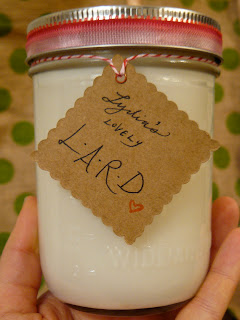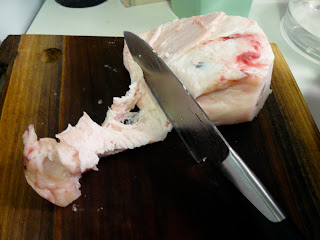How did you first get involved in food swapping? How long ago?
This past February food
swap in SF was my first "official" swap! I only heard about the idea
a few months ago in Minnesota, and as soon as I did I wanted to be involved.
Unfortunately I was a bit late and heard about it just as the MN-Department of
Agriculture was having talks with the swappers around issues of closure. Then I
moved to California to be part of the Cooking and Culinary Traditions
Apprentice Program at Three Stone Hearth Community Supported Kitchen in
Berkeley, and was eager to participate in the exciting idea of food swapping
here in the Bay Area. The idea of horizontal economies and food trade is
something I participate in at home on a small scale, trading cooking lessons,
homemade soups, and ferments for acupuncture, massage, and other delectables
from talented friends and acquaintances. I love the idea of trade!
 |
| Creamy white leaf lard for the swap |
I brought some lovely
homemade, hand-rendered lard from pastured pigs. This lard is a truly sacred
and delicious food. Full of vitamin D from pigs out in the sunshine! I met
these pigs last year and saw how happy and carefree they are. Josh and Rama
at Turnip Rock Farm in
New Auburn, Wisconsin, have some of the best produce and pork in the Midwest! I
have been a CSA member of theirs for 3 years and thoroughly enjoy every radish
and romanesco. I brought this lard because I am passionate about animal fats
from animals raised on pasture. A human brain is about 60% fat (dry weight) and every membrane of every cell and every organelle inside of cells are made of fats. Many hormones, neurotransmitters, and other active substances in the body are made of fats and as such fats are extremely important parts of our diet as humans! The question then comes to be — which fats? And the answer is fats that people have been using for millennia — animal fats such as ghee, butter, pork fat, duck fat, goose fat, chicken fat, and various ruminant animal tallows. Unfortunately the food industry has not only demonized fats, but indeed the animal fats they would sell us come from confinement animals, which store drug residues and other toxins in their fat. I believe in rendering fats at
home with fats from small family farms and using them exclusively in my
cooking- not only to promote health and heal the earth and our bodies — but
because it makes things generally taste straight-up, bang-on, out-of-this-world
amazing! I rendered this leaf lard, which is the fat around the kidneys and
generally thought to have the best flavor, at my home in Minneapolis, and then
brought it to the Bay Area. The pastime of rendering fats is one I am
passionate about and love to share and teach others. If you are interested — please contact me! You can use the fat for frying as it has a fairly high smoke
point of 375° F/188° C. Lard makes the most pliable and dependably flaky crust
for pies and all sorts of baked goods. In fact there is no
substitute! Using it puts us in contact with our grandmothers and
great-grandmothers, who used pastured lard (for back then there was no such
thing as a factory farm, or hydrogenated lard with BHT preservative) for all
their fryin' and bakin'. My favorite thing to put lard into is a roasted
butternut squash that I then puree with a bit of sea salt, honey, and cinnamon.
Makes a little sweet and rich dessert!
Just as I love the idea of
apprenticeship and internship, I love the idea of trade. I feel it can benefit
the world and bring great healing to the economy for us as individuals to come
together and be more interdependent — trading what skill we have for another’s
skill. We all must let go of the individualistic atomic dream of having
everything and needing no one — there is no need to go even one more minute down
that path as a society. And so I think that what I might naturally be gifted
at — say, cooking a broth or rendering lard — might be useful to someone who is
brilliant at something I'm not — say, someone who loves to garden but can't
steam a carrot. We could then get together and start an exchange of time and
skill, while also creating community. As we trade skills we are also deeply
respecting one another. I find food swaps to be a natural extension of this
philosophy.
Who or what most influences your cooking?
Healing. The
concept of healing through diet influences every chop of onion, every
slice of lemon, and every roasting of bird. Right now in my life I am all about
connecting the dots. I am all about healing through the
puzzle. I am all about bringing the news of healing through food to others who
are suffering nutritionally. I want to do this on a larger scale than just at
home — because I have seen firsthand the malnutrition of my fellow peers through
my life experiences. I believe the kind of food I create is the kind of food
that can heal the world and connect us to the earth.
What’s your favorite kitchen tool?
My hands. Getting in touch
with my food, quite literally, is an energetic and bacterial exchange that is healing
and brings great taste and splendor to both the journey and the eventual
outcome on the plate or in the jar. It also helps me to feel more connected to
my ancestors. I believe in connecting to your food using the most exquisite
tool created.
Your current flavor or ingredient obsession?
That would have to be a
tie — I get obsessed often and with great gusto! At the moment I'm pretty
obsessed with fermented preserved lemons, homemade coconut vinegar shrubs, tiny
one inch cinnamon sticks, and grass-fed beef shank curry.
Gizzards and hearts. I
have started to eat pastured chicken gizzards and hearts lately, sometimes I
confit them in duck fat or schmaltz with shallots and herbs de Provence,
sometimes I fry them with Tex-Mex spices, apple cider vinegar, and garlic. This
is not something I grew up with by any means, and so each time I am surprised
that I love the rich, organ-y, chicken-y bits of goodness!
If the Rapture came tomorrow, what would your last meal on earth
be?
Quite a feast! A bison rib
eye grilled rare with many maitake, oyster, and chanterelle mushrooms
caramelized in duck fat and grass-fed spring butter, lots of grass-fed roasted
bone marrow spread on a really fermented sourdough with parsley, lemon, and
garlic, a big glass of purple carrot juice with fermented cod liver oil, a
cornucopia of sustainable caviar, pastured chicken livers from a freshly
butchered chicken seared medium rare with lard-fried sage and marjoram leaves,
raw oysters, a shot of sauerkraut brine in a warm steaming cup of thick
gelatinous beef broth, mashed roasted cauliflower with browned grass-fed butter
and onions roasted in grass-fed tallow and sparkly red peppercorns, soft-boiled
goose eggs, a platter of ferments from every country around the world,
long-simmered black beans with garlic and onion and bacon fat, a salad of
multi-hued radishes with jicama, cilantro, fermented green tomatoes, white
onion, and cayenne pepitas, a compote of blood oranges dripping with cinnamon
and raw buckwheat honey, a plate of roasted pastured chicken skins and wings
and gnarled braised feet with sea salt and thyme, toasty sopes with smoky pork
adobo mole, pan-fried walleye with mashed celery root and glazed carrots with
rosemary, roasted candy pumpkin claufoutis baked with pastured lard, pastured
eggs, and reduced apple honey syrup. Raw milk warmed with raw spun honey,
cocoa, and cinnamon. A big homemade bratwurst with lacto fermented pickles and
red cabbage with sautéed apples and caraway. Thanksgiving stuffing. And lots
and lots of chocolate and cheese, preferably super fermented and ripe! Let the
Rapture begin!
When I'm not in the kitchen I'm _________.
reading.
taking a walk and smelling the earth. smiling. listening to records. making
collages and cards for loved ones.
Favorite local food experience:
Well, since moving to the
Bay Area in January, I would have to say getting to know the local vendors at
the farmers markets and having the pleasure of purchasing from an all organic
farmers market in Berkeley has been quite a pleasure. Also sampling all the
local charcuterie, and swapping!
Heaven Honey Drops
I just made this recipe up
the evening before the swap- feel free to add or change according to your
palate. Enjoy your sweet heaven honey drops! The nourishing mix of coconut with
the raw enzymatic component of the honey allows us to enjoy the ancient
honey-medicine-food with the stability of the coconut oil and fat in the meat-
allowing for a much more stable blood sugar response and a steady, even energy
boost from the medium-chain triglycerides in the coconut oil and the essential
lauric acid!
Ingredients:
1 1/2 cup of Raw Coconut
Butter (I used Artisana Brand)
1 cup of Raw Honey (I used
Meadowfoam honey from Beekind that I got from the Saturday SF Farmers Market)
zest of one or two Meyer
lemons (I used the one from my landlords front yard, so while not organic,
definitely grown with love and care!) - you want around 1 T. plus 1 t for
garnish.
one crushed 1-inch
cinnamon stick (I used an organic one from Lhasa Karnak Herbs on Shattuck in
Berkeley), or ground cinnamon to dust over the top.
Equipment:
one glass or stainless
steel bowl
one wooden spoon
one glass plate
stovetop or heating
element
fridge or cooling element
1. If coconut butter isn't
at room temp and spoonable, carefully heat the jar in a pot with water filled
to halfway up the jar level. Use only the gentlest of heat in order to keep it
raw. This will ruin the label a bit, but makes it much easier to scoop out.
2. Scoop coconut butter
into a bowl.
3. If raw honey isn't
spoonable, carefully heat that using a double boiler or the method above. Try
not to heat the honey and only warm it so that it is workable.
4. Add the honey to the
coconut butter in the bowl.
5. Add the lemon zest,
remembering to reserve a teaspoon or so for the top.
6. Mix the honey, coconut
butter, and lemon zest together with your hands or with a spoon, or both. The
coconut butter will exude a lot of watery, milky liquid as the solids fuse with
the honey. Don't worry about this. Or better yet, when you are done, save it to
drink.
7. Now comes the fun part!
Get yr plate and start rolling tiny little balls, around the size of a marble
or smaller, and placing them on the plate. They will melt a bit with the heat
of your hands so that by the time they sit on the plate they will flatten.
Continue until all the mixture is done.
8. Dust with the ground
cinnamon stick or ground cinnamon and add a few strips of zest to each
drop.
9. Refrigerate for a few
hours or overnight to harden. If traveling somewhere with these (i.e. to the
swap!) I recommend freezing for a few hours.
10. Enjoy!











.JPG)



.JPG)









.JPG)
.JPG)
.JPG)
.JPG)
.JPG)
.JPG)



.JPG)













